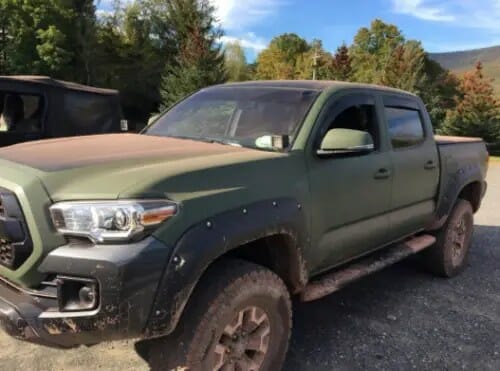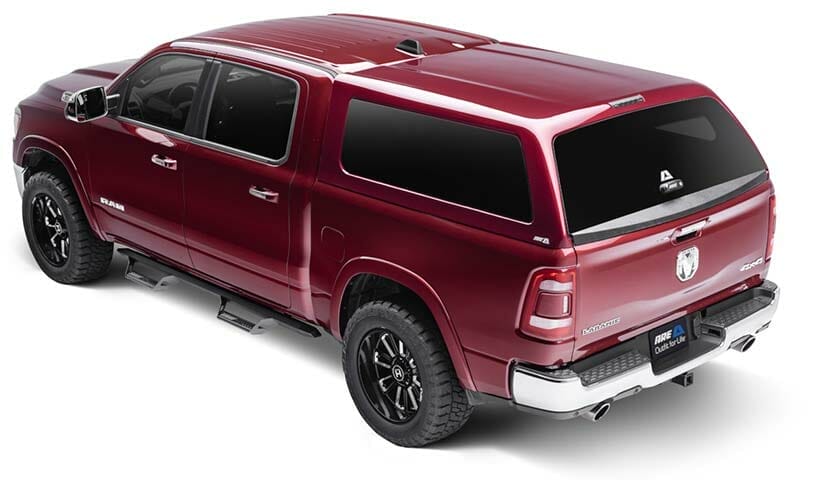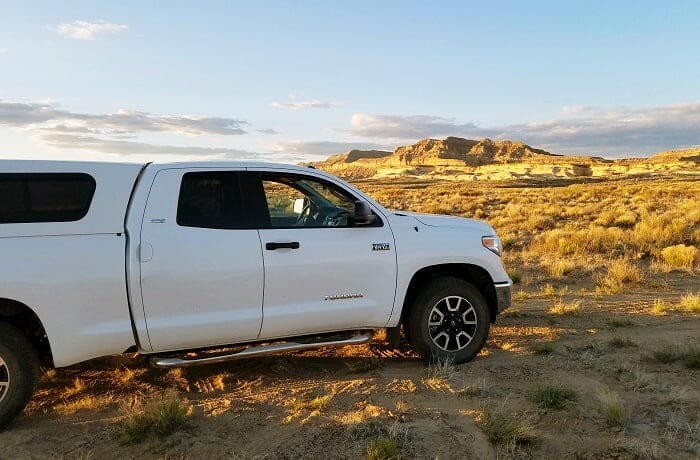If you’re looking to give your truck cap a fresh new look, you might be wondering how much it would cost to have it painted. The cost of painting a truck cap can vary depending on various factors, such as the size of the cap, the type of paint used, and the complexity of the design. In general, you can expect to pay anywhere from $200 to $800 for a professional paint job. However, it’s always a good idea to get a quote from a few different painters to compare prices and find the best deal.

Factors Affecting the Cost of Painting a Truck Cap
If you own a truck cap and are considering getting it painted, it is important to understand the factors that can affect the cost of this service. Painting a truck cap is not a one-size-fits-all endeavor, as there are various elements that can impact the overall cost. By being aware of these factors, you can better estimate the cost and make an informed decision. In this section, we will explore the key factors that influence the cost of painting a truck cap.
Type of Paint
The type of paint used is one of the major factors that contribute to the cost of painting a truck cap. There are different types of paint available, each with its own price range. Generally, high-quality automotive paint tends to be more expensive than regular paint due to its durability and longevity. Some paints may also require a specific application process, which can impact the overall cost.
Color and Finish
The color and finish you choose for your truck cap can also affect the cost. Certain colors or finishes may require additional coats of paint or specialized techniques, resulting in a higher price. Metallic or pearl finishes, for example, tend to be more expensive than solid colors. Additionally, custom colors or intricate designs may require more time and effort from the painter, leading to an increase in cost.
Preparation and Repair
The condition of your truck cap prior to painting can impact the cost as well. If the cap has any dents, scratches, or rust, these issues will need to be addressed before the painting process can begin. The degree of preparation and repair work required can vary depending on the condition of the cap, and this will affect the overall cost. Repairing dents or rust, filling in scratches, and sanding the surface to ensure a smooth finish all require time and expertise, which can increase the cost.
Complexity of Design
If you are opting for a custom design or intricate patterns on your truck cap, the complexity of the design will influence the cost. More intricate designs require additional time and precision from the painter, which can result in higher labor costs. Additionally, if you are looking for custom graphics or decals, these will need to be factored into the overall cost as well.
Size of the Truck Cap
The size of your truck cap also plays a role in determining the cost of painting. Larger caps require more paint and may take longer to complete, leading to higher material and labor costs. It is important to consider the size of your truck cap when estimating the overall cost of the painting project.
Location and Labor Rates
Lastly, the location of the painting service and prevailing labor rates in that area can affect the cost. Labor rates can vary significantly between regions, so it is worth checking with multiple service providers to compare prices. Additionally, if you choose a reputable painter with a high level of expertise, you may expect to pay more for their services.
In summary, several factors influence the cost of painting a truck cap. These include the type of paint, color and finish, preparation and repair work, complexity of design, size of the cap, and location and labor rates. By considering these factors and obtaining quotes from different painters, you can get a better idea of the cost and make an informed decision.

DIY vs Professional Painting: Pros and Cons
Whether you’re looking to freshen up the walls of your home or give a new look to your office space, painting is a popular choice for a quick and effective transformation. However, when it comes to painting, you have two options – doing it yourself (DIY) or hiring a professional painter. Both options have their advantages and disadvantages, and it’s important to weigh them before making a decision. In this section, we will explore the pros and cons of DIY painting versus hiring a professional.
DIY Painting
Many homeowners choose to take on the task of painting their own walls due to cost considerations and the satisfaction of completing a project themselves. However, before diving into a DIY painting project, it’s essential to consider the following pros and cons:
Pros of DIY Painting
- Cost-effective: One of the most significant benefits of DIY painting is the potential cost savings. By painting the walls yourself, you can eliminate the labor costs associated with hiring a professional painter.
- Flexibility and control: When you decide to tackle the painting project yourself, you have complete control over the colors, finishes, and techniques used. You can customize the project to your specific preferences and make changes as you go along.
- Sense of accomplishment: Completing a DIY painting project can be incredibly satisfying. It gives you a sense of pride and accomplishment, knowing that you transformed your space with your own efforts.
- Learning experience: Taking on a DIY painting project allows you to learn new skills and gain experience in home improvement. It can be a fun and educational experience, especially if you enjoy hands-on projects.
Cons of DIY Painting
- Time-consuming: Painting can be a time-consuming task, especially if you’re not experienced or efficient in the process. It may take longer than anticipated, which can be inconvenient, particularly if you have a tight schedule.
- Lack of expertise: While painting may seem like a straightforward task, achieving professional-looking results requires skill and expertise. Without proper knowledge of techniques, equipment, and paint selection, you may end up with subpar results.
- Physical labor: Painting involves physical labor, including moving furniture, preparing surfaces, and applying multiple coats of paint. It can be physically demanding, especially for large or difficult-to-reach areas.
- Potential for mistakes: Without the experience of a professional painter, there is a higher chance of making mistakes. These can include uneven paint coverage, visible brush strokes, or color variations.
Hiring a Professional Painter
If the thought of taking on a DIY painting project seems overwhelming or if you want a high-quality finish, hiring a professional painter may be the best option. Consider the following pros and cons before making a decision:
Pros of Hiring a Professional Painter
- Expertise and experience: Professional painters have the knowledge, skills, and experience necessary to deliver exceptional results. They are trained in various painting techniques and can provide valuable advice on colors, finishes, and products.
- Time-saving: Hiring a professional painter saves you time and effort. They have the tools, equipment, and manpower to complete the project efficiently and within a specified timeframe.
- High-quality finish: Professional painters are skilled in achieving a flawless and professional-looking finish. They have the expertise to handle potential challenges such as repairing damaged surfaces or dealing with intricate details.
- Insurance and warranties: Reputable professional painters often offer insurance coverage and warranties on their work. This provides peace of mind, as any unforeseen issues or damages can be rectified without additional costs.
Cons of Hiring a Professional Painter
- Higher cost: Hiring a professional painter can be more expensive compared to a DIY project. The cost includes labor, materials, and any additional services provided by the painter.
- Less control: When you hire a professional, you have less control over the project. While you can provide input and preferences, ultimately, the painter will make decisions regarding techniques and materials.
- Scheduling constraints: Professional painters may have a busy schedule, which could result in longer waiting times before they can start the project. This can be challenging if you have a specific timeline in mind.
Summary
When it comes to deciding between DIY painting and hiring a professional, it ultimately depends on your

Popular Paint Colors and Finishes for Truck Caps
When it comes to personalizing your truck cap, choosing the right paint color and finish can make all the difference. Not only does it enhance the overall look of your vehicle, but it also adds a layer of protection to your truck cap. In this section, we will explore some of the most popular paint colors and finishes for truck caps, helping you find the perfect combination for your style and needs.
1. Glossy Finishes
Glossy finishes are a classic choice for truck caps. They offer a sleek and shiny appearance that can make your vehicle stand out on the road. The reflective nature of glossy finishes adds depth to the color and gives a polished look. Popular glossy paint colors for truck caps include black, white, red, and metallic shades like silver and blue. These colors are timeless and versatile, complementing any truck design.
2. Matte Finishes
If you prefer a more understated and modern look, matte finishes are an excellent choice. Unlike glossy finishes, matte finishes have a flat or non-reflective surface, providing a muted and sophisticated appearance. Popular matte paint colors for truck caps include gray, charcoal, army green, and dark blue. These colors exude a sense of elegance and can give your truck cap a unique and contemporary touch.
3. Textured Finishes
For those who want to add texture to their truck caps, textured finishes offer a distinct and rugged appeal. These finishes simulate the look and feel of materials like sandstone or pebbles, adding visual interest and creating a more tactile experience. Textured paint colors for truck caps often include earthy tones like tan, brown, and olive green. These colors are perfect for outdoor enthusiasts or those who want a more adventurous look.
4. Metallic Finishes
Metallic finishes are a popular choice for truck caps due to their eye-catching and luxurious appearance. These finishes contain metallic flakes that reflect light, resulting in a sparkling and dynamic finish. Popular metallic paint colors for truck caps include silver, gold, bronze, and copper. These colors give your truck cap a premium look and can elevate its overall aesthetic.
5. Custom Colors and Finishes
If you want to go beyond the standard paint colors and finishes, many manufacturers offer custom options to suit your preferences. This allows you to choose a color that matches your truck’s exterior or create a unique combination that reflects your personal style. Custom finishes can include pearl, candy, or two-tone paint options. Keep in mind that custom colors and finishes may require additional time and cost, but the result will be a truly one-of-a-kind truck cap.
In summary, when choosing the paint color and finish for your truck cap, consider your personal style, the overall look of your vehicle, and the level of protection you desire. Whether you opt for a glossy, matte, textured, metallic, or custom finish, selecting the right paint color and finish can transform your truck cap into a statement piece that reflects your individuality and enhances your driving experience.
Tips for Maintaining the Paint on Your Truck Cap
Keeping the paint on your truck cap looking fresh and vibrant not only enhances its appearance but also helps protect it from damage caused by the elements. Here are some useful tips to help you maintain the paint on your truck cap for years to come:
1. Regular Washing
Regularly washing your truck cap is essential for preserving its paint. Use a mild automotive soap and water to gently clean the surface. Avoid using harsh detergents or abrasive materials that could scratch or damage the paint. Rinse thoroughly and dry with a soft, clean cloth or chamois to prevent water spots.
2. Waxing
Periodically waxing your truck cap can provide an extra layer of protection for the paint. Choose a high-quality automotive wax specifically formulated for painted surfaces. Apply the wax using a soft cloth or sponge, following the instructions on the product. Buff the waxed surface to a shine using a clean, dry cloth. Waxing helps seal the paint and acts as a barrier against dirt, UV rays, and other contaminants.
3. Avoid Scratches and Chips
Preventing scratches and chips is crucial for maintaining the paint on your truck cap. Avoid parking too closely to other vehicles or objects that could potentially cause damage. Use caution when loading and unloading items from the truck bed to prevent accidental scratches. Consider investing in a bed liner or using protective padding when carrying heavy or sharp-edged objects.
4. Protect from Sun Exposure
Extended exposure to direct sunlight can cause the paint on your truck cap to fade and deteriorate. Whenever possible, park your truck in shaded areas or use a car cover to shield it from the sun’s harmful rays. If parking in the open is unavoidable, consider using a UV protective spray or wax on the exposed surfaces to minimize damage.
5. Touch-up Paint
Inevitably, small scratches or chips may occur on your truck cap’s paint over time. To minimize their appearance and prevent further damage, promptly touch up any exposed areas using a matching touch-up paint. Follow the instructions provided with the touch-up kit and carefully apply the paint using a fine brush or applicator. Allow the paint to dry completely before exposing it to the elements.
6. Professional Detailing
If you want to go the extra mile in maintaining the paint on your truck cap, consider getting it professionally detailed. Professional detailing involves a thorough cleaning, polishing, and waxing of the paint surface, leaving it looking like new. Additionally, detailing can help remove any stubborn stains or contaminants that regular washing might not eliminate.
In summary, by following these tips for maintaining the paint on your truck cap, you can preserve its beauty and protect it from damage caused by everyday wear and tear. Regular washing, waxing, and avoiding scratches and sun exposure are key to extending the life of your truck cap’s paint. And when necessary, don’t hesitate to touch up the paint or seek professional detailing services for a more comprehensive restoration.
FAQs
1. How much does it cost to paint a truck cap?
The cost of painting a truck cap can vary depending on various factors such as the size of the cap, the type of paint used, and the complexity of the design. On average, you can expect to pay anywhere from $200 to $500 for a professional paint job.
2. Can I paint a truck cap myself?
Yes, you can paint a truck cap yourself if you have the necessary tools and skills. However, keep in mind that painting requires proper preparation and technique to achieve a smooth and long-lasting finish. It is recommended to seek professional help if you are unsure about your painting abilities.
3. How long does it take to paint a truck cap?
The time it takes to paint a truck cap depends on several factors, including the condition of the cap, the number of coats needed, and the drying time between each coat. On average, the painting process can take anywhere from a few days to a week, considering the necessary preparation, painting, and drying time.
Wrapping Up
In conclusion, painting a truck cap can greatly enhance its appearance and protect it from corrosion. The cost of painting a truck cap can vary depending on several factors, such as the size of the cap, the type of paint used, and the labor involved. It is recommended to get quotes from professional painters to get an accurate estimate. Additionally, DIY painting is also an option for those on a budget, but it may require more time and effort.
Regardless of the approach, a fresh coat of paint can transform a truck cap, giving it a new lease of life and increasing its resale value. So, whether you choose to hire a professional or take on the task yourself, painting your truck cap is a worthy investment that will make a noticeable difference.
